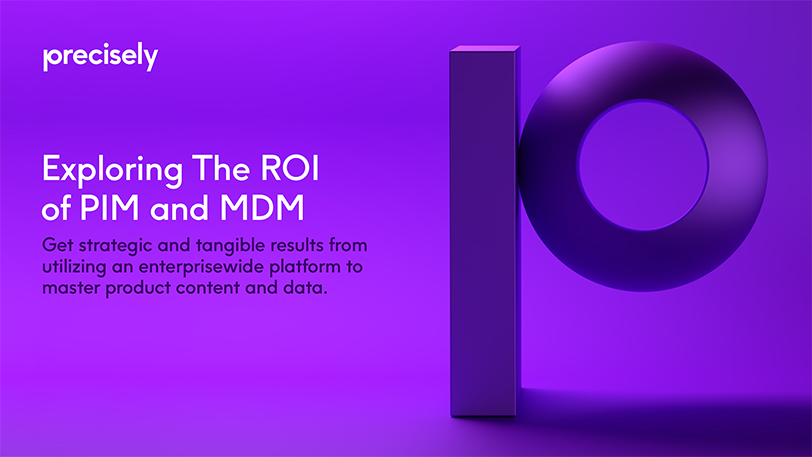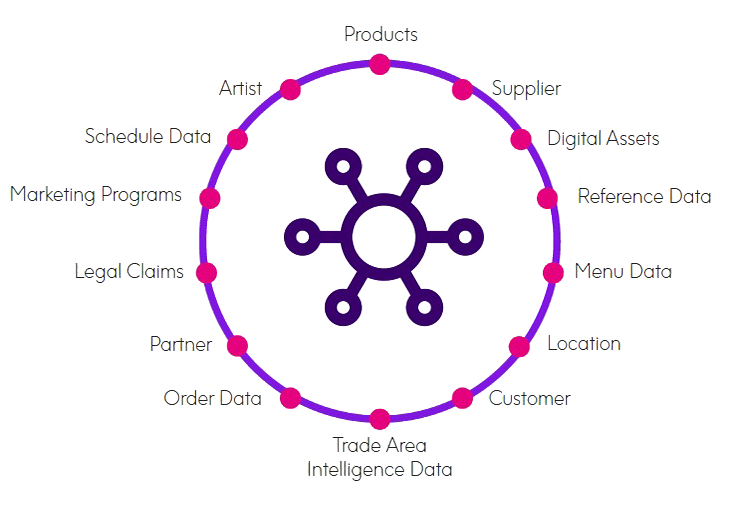eBook
Exploring the ROI of PIM and MDM
If you’re responsible for your company’s product information, calculating the ROI of a Product Information Management (PIM) and Master Data Management (MDM) platform is a crucial step in your journey.
In this eBook, we’ll explore what industry analysts, solution experts, and actual business users have to say about the measurable impact of PIM and MDM on their organization.

Start Here: Operational Excellence
At the heart of MDM and PIM solutions is the ability to provide the “single view” of product data and content across the enterprise, which can reduce the complexity, cost, and time associated with multiple business initiatives and requirements.
Consider some of the essential strategic areas of ROI for PIM/MDM platforms, as agreed upon by most of the industry’s analysts and observers.
- Reduce time to market
- Enable international growth
- Ensure fewer stockouts
- Improve supplier and partner collaboration through Vendor Portals
- Reduce errors and discrepancies
- Lower integration costs
Workflow-Powered PIM
A Yankee Group1 study on PIM ROI suggests high return on investment just through basic improved processes: Companies surveyed reported an average 25 percent savings from their PIM solutions across 18 business functions, with an average of 2,500 person-days saved. The key to improved efficiencies starts with the workflow-powered nature of PIM.
The workflow component of an enterprise PIM/MDM system provides the “kinetic energy” that underlies the applications that leverage product content. A workflow-powered PIM/MDM solution enables knowledgeable individuals from merchandising, brands, marketing, channels, or suppliers contribute product content via automated processes and paths. This helps organizations bring products to market faster, publish catalogs more efficiently, reduce errors, easily collaborate with vendors, and keep e-commerce sites dynamically up-to-date.
The Big Picture
Finally, it’s important to note that these benefits aren’t the result of simply managing master data or product information. These capabilities are inert unless integrated with business applications that leverage the data, such as multi-channel publishing and dealer portals.
With a PIM/MDM platform, companies can deliver this centralized product information effectively through efficient, automated business processes and integrated solution capabilities.

Measurable ROI – Yankee Group Survey
of respondents increased sales resulting from an improved relationship with retailers and dealers
reported reduced logistical costs through better replenishment planning
said inventory levels reduced through better phasing of promotional, seasonal, or roll-over SKUs
Charting a Course for Superior Customer Experience
Provide a Consistent Experience
Over 70 percent of online buyers rely on product information when considering a purchase. Yet with so much exposure to your products in so many different media and locations, it is harder than ever to ensure consistently accurate product information. Getting it wrong even once can jeopardize your credibility and earned consumer trust.
A PIM solution enables you to improve customer satisfaction by providing them with better, richer product information and ensuring that the information is complete and consistent across all interaction points.
Provide a Differentiated Experience
In the digital age, customer-obsessed businesses in both B2C and B2B must be laser focused on delivering differentiated experiences. According to Forrester’s report, Polishing Up Your Products – Why PIM Really Matters2, “eBusiness leaders and marketers are critically reliant not only on their product data, but on curated product content” to do so. Furthermore, blending experiences across channels is a key ingredient of specifically targeting omnichannel-savvy shoppers, who are found to be more valuable than single-channel shoppers. A study by the Harvard Business Review found that omnichannel shoppers spend more across channels, plus, more specifically, in the store. They are also more likely to share their positive experience with family and friends and to post positive reviews online.


According to Forrester, 69% of online buyers rely on e-commerce features with information typically enabled by a PIM solution.3
Intersecting with E-commerce
Today, online shoppers read less text but consume more content. When shopping and researching, consumers want the full product story, including images, videos, attributes, and peer reviews. And the content must be reliable, consistent, granular, and persuasive.
In fact, according to Forrester’s report,3 the analyst firm found in their research that: “71 percent of all US online adults who research products online use myriad pieces of product information including social ratings and reviews, digital assets, and editorial
content from the manufacturer or retailer to help them in their purchase consideration process. By contrast, just 57 percent consider shipping costs in their decision.”
When it comes to e-commerce expansion, a PIM platform helps sellers and manufacturers:
- Produce better search results through granular product details
- Improve discoverability and relevance across Google.com, Google Shopping, and other major marketplaces
- Provide accurate, consistent, and persuasive content across channels
- Seize upselling and cross-selling opportunities through product associations, which can translate to an increase in sales of up to 20 percent
- Decrease product return rates and boost positive reviews
The Product Hub
A key benefit of PIM/MDM is the ability to serve as a product insight hub for your business, as well as ensure that your products are meeting the needs of consumers, trading partners, and regulatory agencies.
– Peter Sheldon, Principal Analyst at Forrester5

Eighty-two percent of US online adults indicate it’s important for them to refine search results by product attributes such as price, brand, style, etc. Firms can utilize PIM/MDM platforms for search engine-optimized product copy plus well-organized taxonomies and hierarchies.

Regulatory compliance is consistently mentioned in most industry surveys and studies as one of the most compelling business reasons for implementing PIM/MDM. It helps ensure that a company’s relevant business rules and procedures for data entry, taxonomy, categorization, and other parameters are enforced in order to ensure precision in information around regulated products.

According to Forrester products tied to video see 2.5 times more conversions compared with those that don’t have video.6 This is just one example of the importance of relevant and accessible digital assets for today’s shoppers. PIM platforms can offer integrated DAM capabilities to facilitate the linking of product data to rich media assets such as product videos, images, and marketing materials or product guides.

Outside PIM, organizations often lack a purpose-built repository for sales support and customer support materials including manuals, videos, or related collateral. PIM offers the ability to link materials to products within a repository that is accessible across many roles, with the ability to refresh and upload new materials with ease.
Getting Lost without PIM
The impact of ineffective product information is glaringly clear for retailers, manufacturers, and distributors. Consider the following statistics from A.T. Kearney6:
- Nearly 30 percent of the item data in catalogs used by retailers and manufacturers is incorrect; correcting those errors costs between $60 and $80 each.
- Companies spend an average of twenty-five minutes per SKU each year manually cleansing out-of-sync item information.
- Without a PIM system, product introductions and rollouts take an average of four weeks due to inefficient and error-prone approaches to exchanging and updating new item attributes.
Therefore, as companies consider how they can work a PIM/MDM implementation into their roadmap, they also need to consider the cost of failing to implement such a system. The following “ROI killers” can impact companies without PIM:
- Lack of confidence in the accuracy and consistency of product information fosters customer dissatisfaction and increases product returns
- Missed product launch deadlines due to inefficiencies in optimizing and syncing product content, attributes, and digital assets
- Delayed e-commerce growth due to data issues and poor product search results
- Difficulty growing product assortment from insufficient supplier information and lack of collaboration around a trusted, centralized source of information
- Fractured workflow and difficulty locating product information in roles across your organization, resulting in loss of time and resources
Real Life Results
Now that we’ve discussed how PIM impacts your ROI, let’s take a look at some real-life results from business users leveraging EnterWorks PIM/MDM solution:
Faster time-to-market by reducing a monthslong catalog cycle down to four weeks with increased accuracy and improved workflow
- Cutting six months and six figures from the production cycle of a 1,400-page catalog, with 2 percent increase in sales and 4 percent increase in gross margins over the first six months
- Storing, managing, and publishing product information 25 to 30 percent faster than pulling data from source documents
- Shortening production for a 2,200-page catalog by 70 percent, reducing resource requirements by half, and cutting inaccuracies from 25 percent to less than 5 percent
- Capturing $17 million in additional revenue with a real-time MDM-based pricing portal
- Realizing an eightfold gain in productivity, including the ability to produce customized catalogs
- Managing fourteen subsidiaries from one product MDM system to support mass customization across multiple brands


Connecting the Dots with Multi‑Domain MDM
Is your data stuck in silos? This is the reality for many businesses that attempt to master data via single domains like customers or products. Siloed data results in poor quality/governance, inefficiencies, and waste.
By contrast, Multi-Domain MDM platforms are flexible, open and adaptable. They connect the dots for data including product, customer, supply, location, assets, employees, and more.
A Multi-Domain MDM solution allows users to manage multiple domains of data and easily link objects from those domains to create dynamic virtual relationships.
All administrative, stewardship and governance functions across the multiple domains (and implementation styles) can be achieved from a single UI − creating a long-term solution for one version of the truth.
Beginning Your Journey
For businesses large and small, a PIM/MDM solution can be game changing. Partnering with the right product content experts and selecting a flexible yet advanced platform can help you achieve your immediate and long-term goals.
If you’re considering a PIM or MDM solution, we hope you’ll contact us. We’d enjoy learning more about your company, discovering your product information challenges, and discussing how our solutions can help address your needs and opportunities for growth.
- Revolutionary Agile Data Fabric™ technology weaves together data domains
- Business-friendly platform for high user adoption, no coding required
- Hosted private cloud SaaS, your private cloud, on-premise, or hybrid
- Perpetual, term, and SaaS licenses
- Lowest total cost of ownership
- Fastest go-live times in the industry
1. Yankee Group Study , ROI of PIM for Product Data
2. Polishing Up Your Products – Why PIM Really Matters, Peter Sheldon with Zia Daniell Wigder, Michele Goetz, Rebecca Katz, Forrester Research, November 19, 2014
3. A Study of 46,000 Shoppers Shows That Omnichannel Retailing Works, by Emma Sopadjieva, Utpal M. Dholakia, and Beth Benjamin, January 3, 2017
4. Forrester, Sheldon
5. Forrester, Sheldon
6. Data Synchronization Proof of Concept: Case Studies from Leading Manufacturers and Retailers, A.T. Kearney